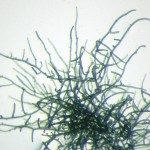Link to Pubmed [PMID] – 31280092
Phytochemistry 2019 Jul;166:112059
The cyanobacterial phylum is currently divided into five subsections (I-V), with the latter two containing no or false-branching (nostocalean) and true-branching (stigonematalean) cyanobacteria. Although morphological traits (such as cellular division and secondary branches) clearly separate both types of heterocytous cyanobacteria, molecular evidence indicates that stigonematalean cyanobacteria (Subsection V) do not form a monophyletic group but instead are interspersed and nested within the nostocalean cyanobacteria (Subsection IV). To further resolve the phylogeny of heterocytous cyanobacteria, we here analyzed the distribution of heterocyte glycolipids (HGs) in the true-branching cyanobacterium Stigonema ocellatum SAG 48.90 (type genus of Subsection V) and compared it with the HG inventory of other stigonematalean and nostocalean cyanobacteria. The most dominant HGs in S. ocellatum SAG 48.90 were 1-(O-hexose)-27-keto-3,25-octacosanediol (HG keto-diol) and 1-(O-hexose)-3,25,27-octacosanetriol (HG triol), which together constituted ca. 94% of all HGs. In addition, 1-(O-hexose)-3-keto-27-octacosanols (HG keto-ols), 1-(O-hexose)-3,27-octacosanediols (HG diols), 1-(O-hexose)-3-keto-27,29-triacontanediol (HG keto-diol) and 1-(O-hexose)-3,27,29-triacontanetriol (HG triol) occurred in minor abundances. Heterocyte glycolipids previously reported to be unique for stigonematalean cyanobacteria, i.e. 1-(O-hexose)-3,29,31-dotriacontanetriols (HG triols) and 1-(O-hexose)-3-keto-29,31-dotriacontanediols (HG keto-diols), were not detected in S. ocellatum SAG 48.90. Comparison of the HG distribution pattern with those of other heterocytous cyanobacteria indicated that S. ocellatum SAG 48.90 is most closely related to the nostocalean families Rivulariaceae and Scytonemataceae, which is complementary to reconstructed 16S rRNA gene sequence phylogenies. Our HG-based data thus provides evidence for the polyphyly of stigonematalean cyanobacteria, independent from molecular approaches, and points to the need for a critical re-evaluation of the current taxonomy of heterocytous cyanobacteria.

